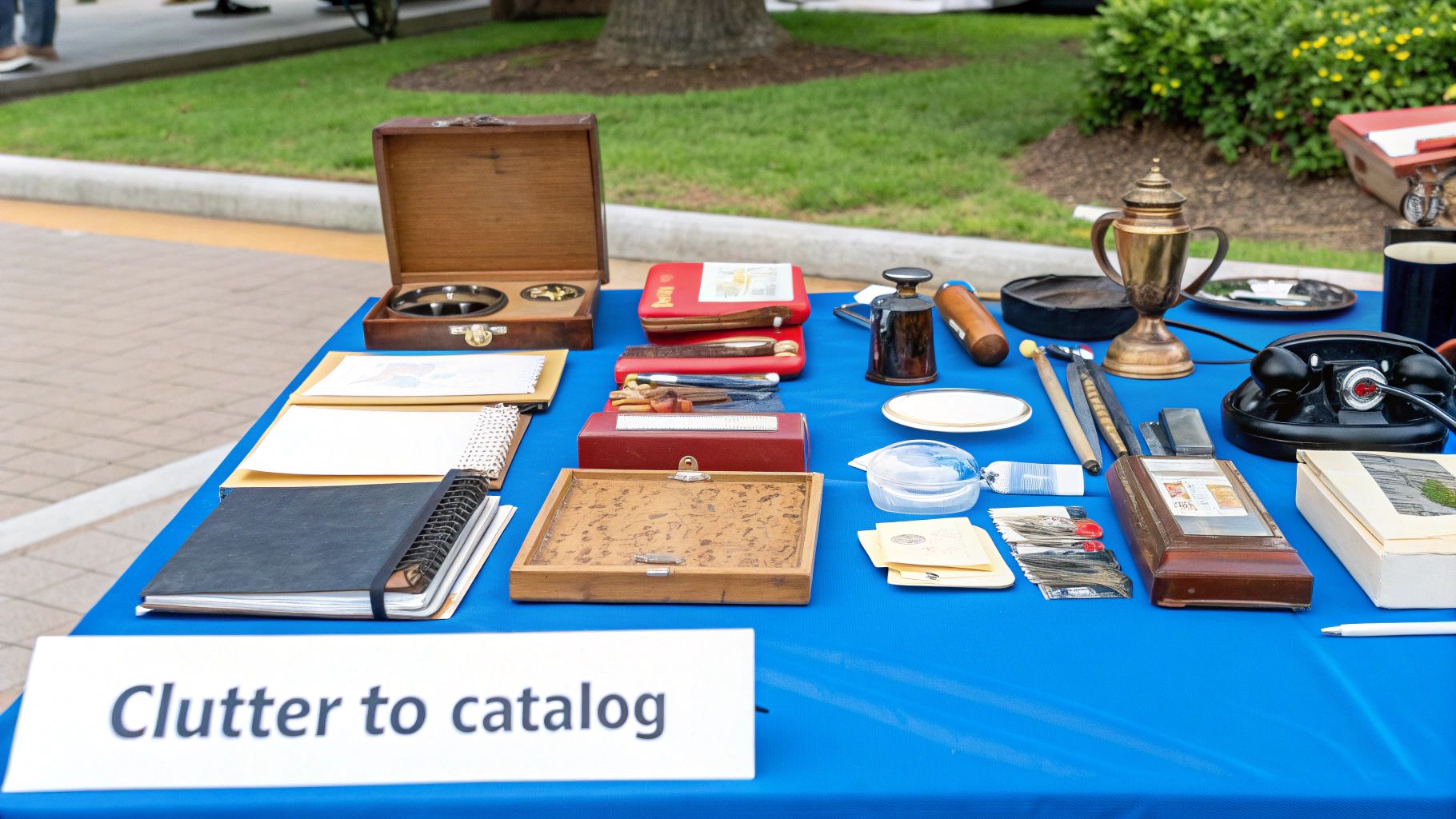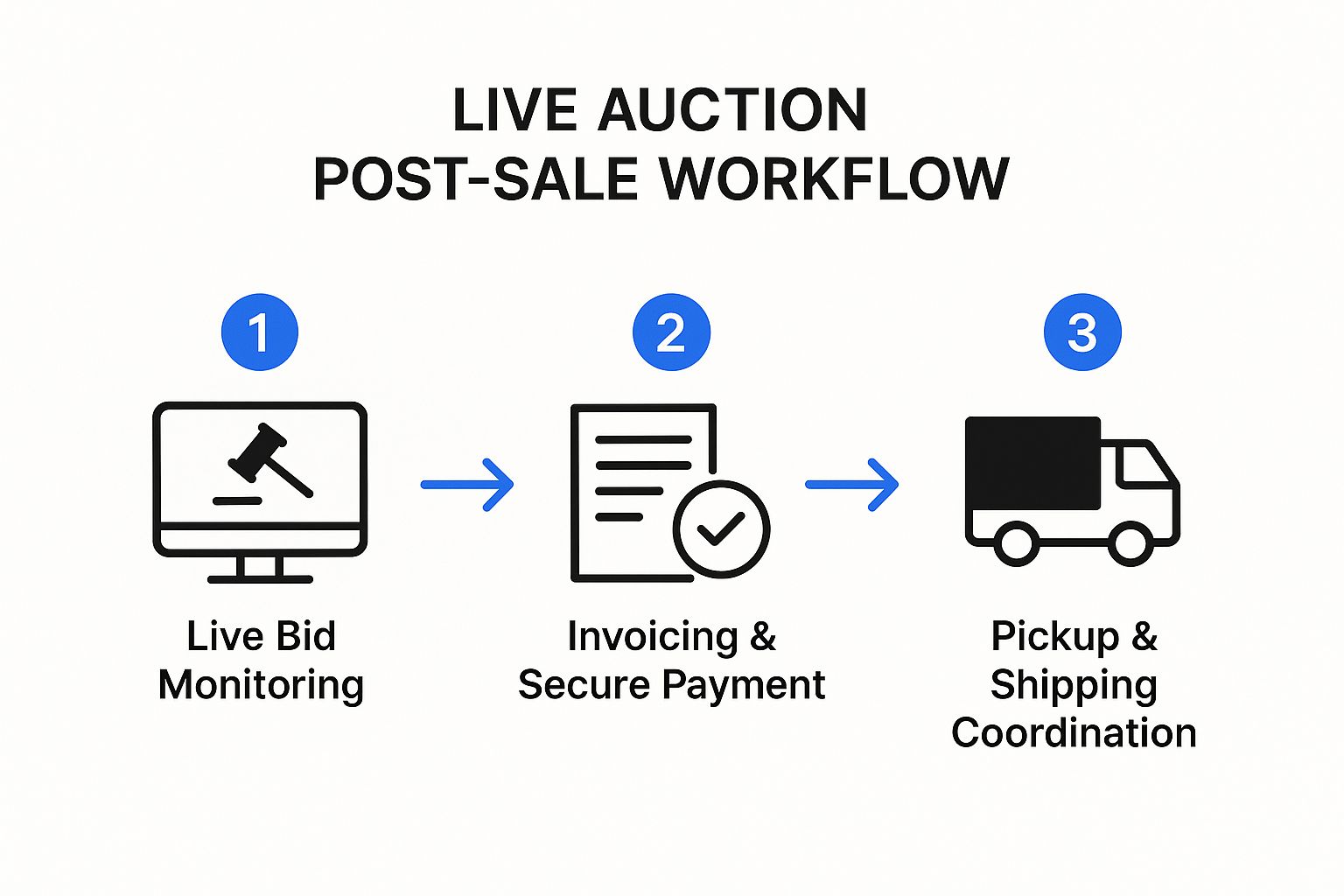Auctioneer How To A Modern Guide to Estate Sales

Learning how to be an auctioneer today is less about fast-talking and more about being a sharp project manager. The job has evolved, blending classic appraisal skills with a heavy dose of digital marketing and logistics coordination. It’s a dynamic role that really requires a strategic approach from start to finish.
What Does a Modern Auctioneer Actually Do?

Forget the old-school image of someone just calling out numbers from a podium. Today's auctioneer is the conductor of the entire estate sale process, often using powerful online platforms to reach a global audience. This shift has turned what was once a local business into a potentially worldwide enterprise.
The global auction house market hit an estimated $35 billion in 2024, which just goes to show the industry's strength. Projections even suggest it could grow to $55 billion by 2033—a clear sign of a healthy, expanding market.
The Core Responsibilities
A successful auctioneer wears a lot of different hats, and you have to be able to switch between them seamlessly to pull off a profitable sale. The work that bidders see on auction day is just the tip of the iceberg.
Here’s what’s really going on behind the scenes:
- Client Consultation: It all starts with meeting the estate owners or executors. You need to understand their goals, their timeline, and the sheer scope of the assets. This initial meeting lays the foundation for everything that follows.
- Item Valuation and Curation: This is where you have to put on your appraiser hat. It means carefully assessing each item's worth, which takes a keen eye for detail, solid market knowledge, and knowing when to call in a specialist for high-value pieces like art or antiques.
- Strategic Marketing: You can have the best items in the world, but if the right buyers don't know about them, it doesn't matter. This involves professional photography, writing compelling item descriptions, and promoting the auction across the right channels to attract serious bidders.
- Event and Logistics Management: This is the project manager role. You're overseeing every detail, from setting up the online catalog to coordinating payments and pickup after the sale. A smooth, organized process is absolutely critical for building a good reputation.
The real skill of a modern auctioneer isn't in the chant—it's in the meticulous preparation that happens behind the scenes. The live event is simply the finale of weeks of strategic planning, research, and marketing.
Ultimately, mastering these duties is what separates a good sale from a great one. For a deeper dive into the specific techniques involved, you might want to check out our guide on how to auctioneer effectively. Learning these fundamentals will give you the confidence to manage an estate sale both professionally and profitably.
From Clutter to Catalog: How to Prep an Estate

Here's a little secret from the auction world: the financial success of an estate sale is almost always locked in before the first bid is even placed. It’s all in the prep work—that methodical, sometimes tedious, process of turning a lifetime of possessions into a curated catalog. This is where the real art lies.
Your initial walkthrough isn't just a quick look-around; it’s a treasure hunt. The goal is to separate the entire estate into broad categories before you start digging into the details. Think of it as creating organized chaos. Getting a handle on the property and its contents is key, which is why a good essential property research guide can be a huge help in understanding the market potential.
Identifying and Researching Key Items
Every estate has its stars—the items that will draw bidders in. Your first job is to spot these potential high-value pieces. It might be a mid-century modern credenza hiding under a pile of blankets, a box of vintage jewelry, or a signed first-edition book on the shelf.
Once you’ve tagged these marquee items, the real research begins. This means digging into past auction results, checking online marketplaces, and knowing when it's time to call for backup.
- Look for 'Sleepers': Keep an eye out for items that seem ordinary but have a dedicated niche following. Old tools, vintage band t-shirts, and even certain types of costume jewelry can sometimes fetch surprisingly high prices from the right collectors.
- Get a Professional Appraisal: When it comes to fine art, genuine antiques, or rare collectibles, never guess. A certified appraiser provides a valuation that not only informs your starting bid but also gives your bidders confidence.
- Value General Goods: For everything else, a quick search on sites like eBay or Replacements, Ltd. will give you a solid baseline value to work with.
A bit of elbow grease goes a long way. Simple cleaning and smart staging can increase an item's final sale price by over 20%. A little polish, good lighting, and a clean background for your photos can make all the difference.
The Strategy of Lotting
Creating a detailed inventory is the bedrock of your auction. You can make this whole process much smoother by learning how to create a personal property inventory list—this list will become the backbone of your online catalog.
From there, you’ll "lot" the items, which is just the industry term for grouping them together for sale. A smart lotting strategy can seriously boost your total revenue. For instance, bundling a set of everyday dishes with a few nice serving pieces creates a much more appealing package than selling them one by one. This approach not only helps move lower-value items but also increases the perceived value of the entire bundle.
Building Your Online Auction for Maximum Bids

Think of your online auction as your digital showroom. How you present it directly influences your final sales. This is where all your prep work comes together to create a live, buzzing event that draws people in.
The global online auction market was valued at an incredible $5.25 billion in 2023, and it’s on track to more than double by 2032. Setting up a professional-looking auction is your ticket to getting a piece of that action. It all starts with building listings that not only look good but also build trust.
If you’re just getting started, our breakdown of the best online auction software is a great resource to understand the tools of the trade.
Crafting Listings That Sell
Every single listing comes down to two things: great photos and a solid description. And no, you don't need a fancy photography studio. Your smartphone, a window with good natural light, and a simple background (like a plain wall or a bedsheet) are all it takes.
Make sure you get these three shots for every item:
- The Hero Shot: A clean, well-lit photo showing the entire item. This is your first impression.
- Detail Shots: Get close-ups of any unique features, signatures, logos, or interesting textures.
- The Flaw Shot: Be upfront. Take a clear picture of any scratches, dings, or wear and tear. Honesty builds bidder confidence and saves you headaches later.
Next up is the description. Keep it simple and easy to scan. Lead with the must-know info: what it is, its measurements, and its condition. Try to think ahead and answer common questions before they’re even asked.
My best advice? Put yourself in the buyer's shoes. What would you want to know before you bid? Always include dimensions, materials, and any interesting history. Being transparent about imperfections is non-negotiable—it prevents post-sale drama and builds your reputation for future sales.
Setting the Stage for a Bidding Frenzy
The technical settings you choose behind the scenes can make or break your auction’s momentum. Here’s a quick-reference guide to the settings we’ve seen work best.
Essential Online Auction Settings
| Setting | Our Recommendation | The Impact |
|---|---|---|
| Starting Bid | Start at $1. | It feels like a no-brainer. This low barrier gets those crucial first bids in, creating social proof and showing others the item is in demand. |
| Bid Increments | Small (e.g., $1-$5) for lower-value items; larger (e.g., $10-$25+) for high-value items. | This keeps the action moving at the right pace. Small steps encourage rapid bidding, while larger ones ensure the price climbs effectively on bigger-ticket items. |
| Auction End Time | Weekday evenings (7-9 PM) or Sunday afternoons. | This is primetime for online traffic. Ending your auction when most people are relaxing at home maximizes the chance of a last-minute bidding war. |
Speaking of bidding wars, creating a sense of urgency is a powerful tool. A great way to do this is to add a countdown timer to your website. Seeing that clock tick down is often just the nudge a hesitant bidder needs to jump in.
Getting the Right Bidders to Your Auction
A perfectly cataloged auction is a great start, but it's only half the job. Without the right audience, even your most valuable items won't get the attention they deserve. The secret isn't just about getting eyes on your sale—it's about getting the right eyes.
Your marketing strategy is what turns a simple online listing into a can't-miss event that brings in motivated buyers ready to compete. Forget casting a wide, generic net. We’re talking about a targeted, multi-channel approach. This isn't just a single social media post and hoping for the best. It's about building a narrative that creates genuine urgency and excitement.
Think about who your ideal bidder is. If you're selling an estate full of vintage electronics, your best buyers are probably hanging out in a specific subreddit or a dedicated Facebook group for hi-fi enthusiasts, not scrolling a generic marketplace. Find them where they are.
Building Excitement with a Marketing Calendar
A well-timed promotional push can make all the difference. Instead of just posting whenever you remember, map out a simple timeline to build and sustain excitement. This keeps your auction top-of-mind and gets people to mark their calendars.
Here’s a simple but incredibly effective schedule I've seen work time and time again:
- One Week Out: This is your big announcement. Post a "sneak peek" video on social media showcasing your top 5-10 items. This gets people talking and sharing. Now is also the perfect time to email your list of past bidders, giving them a first look.
- Three Days Before: Time to highlight the unique stuff. Post high-quality photo galleries of quirky items with an interesting story. Remind your audience of the auction's start date and time. Your ad copy should focus on the scarcity and one-of-a-kind nature of what you’re offering.
- Auction Day: Hit them with a final "last chance" email and post reminders across all your social channels. You want to create a sense of immediacy and let everyone know that bidding is now live.
The most successful auctioneers I know are relentless marketers in the week leading up to a sale. They understand that creating a "fear of missing out" is what drives those last-minute bidding wars that push prices higher.
The North American auction market is a massive space, projected to hit around $9.47 billion in 2025. Tapping into even a tiny piece of this requires reaching buyers where they live online. This just goes to show how critical a strong digital marketing plan is to make your sale stand out. You can discover more insights about the global auction market to get a better handle on these trends.
By strategically targeting niche communities and building real anticipation, you ensure your items get the bids they truly deserve.
Running Your Live Auction & Nailing the Post-Sale Process
Once your auction is live, your job shifts from prep work to active management. This is where all that effort you put in really starts to shine, but you need to stay on the ball to make sure everything runs smoothly and, most importantly, profitably.
Your main task now is simple: be available. Keep an eye on the bidding action right from your DIYAuctions dashboard and be ready to jump on any bidder questions. A quick, helpful answer about an item's condition or pickup details can easily turn a hesitant watcher into a confident bidder. It's often that little bit of reassurance that makes the sale.
After the Bidding Stops: Post-Auction Logistics
The moment the final bids are placed, the next phase of your work kicks off immediately. A professional, organized post-sale experience isn't just nice to have—it's essential. It ensures you get paid on time and helps build a reputation that brings bidders back for your next sale. A messy pickup or confusing payment process can ruin an otherwise great experience for a buyer.
The workflow from here is pretty straightforward, but the devil is in the details. This is the flow you'll follow from the second the auction closes to the moment buyers have their new treasures in hand.

As you can see, a successful sale depends on a seamless handoff from the live event to your backend logistics. Every step flows directly into the next, creating a predictable and positive experience for your winning bidders.
First things first: send out those invoices. The DIYAuctions platform automates a lot of this for you, but it’s always smart to give them a quick once-over for accuracy. This is especially true if you’re combining shipping for someone who won several different lots.
The golden rule of the post-sale phase is clear communication. Make sure your payment deadlines are spelled out in your terms. While a friendly automated reminder for unpaid invoices works wonders, a clear policy from the get-go prevents most headaches.
Finally, it’s time to manage the pickup or shipping. For local pickups, setting a specific, tight window (like Saturday from 9 AM to 1 PM) is the best way to keep things organized and prevent chaos. If you're shipping items, always use sturdy packaging and get those tracking numbers to buyers as soon as you have them. Being transparent at every step is how you build the trust that turns a one-time buyer into a loyal follower.
Your First Few Auctions: Common Questions Answered
Even the most organized person runs into a few head-scratchers during their first online estate sale. It’s totally normal. Getting comfortable with the process is all about knowing how to handle these common situations when they pop up.
Here’s a look at the questions we get asked most often by new auctioneers, along with some straightforward, practical advice.
How Do I Set a Smart Starting Bid?
This is a big one, and there’s no single “right” answer. Your starting bid strategy is a powerful tool for getting bidders excited. Think of it this way: a low start can kick off the action, while a more conservative start protects the value of a special item.
Here are two approaches that consistently work well:
- For Everyday Items: Go with a $1 starting bid. Seriously. For household goods, decor, and common tools, this tiny barrier to entry is fantastic for getting people to click that first bid. It often sparks friendly competition that drives the final price up.
- For Higher-Value Pieces: For that antique dresser or signed piece of art, a good rule of thumb is to start the bidding at 20-30% of its estimated value. This protects your investment while still making bidders feel like they have a shot at a great deal.
The worst thing you can do is set a starting bid too high. It’s an instant momentum killer. Bidders will just scroll right past, and your auction can stall before it even gets going.
What’s the Best Way to Handle a Non-Paying Bidder?
It’s frustrating, but it happens. First off, make sure your auction terms and conditions clearly state your payment deadlines. If a winner goes silent, the first step is always a single, polite reminder.
If that doesn't work, DIYAuctions makes it simple to report the non-payer, which helps keep the community safe for everyone. After that, you have a couple of easy choices. You can send a "second chance offer" to the next-highest bidder or simply hang onto the item and relist it in your next sale. Don't let one bad apple disrupt your whole rhythm.
The single most important part of any item description? Honesty. Buyers would much rather know about a chip or a scratch upfront than be surprised at pickup. Full transparency builds trust and saves you from headaches later.
Should I Offer Shipping on Everything?
Deciding whether to ship comes down to one thing: practicality. Offering shipping can definitely open your auction up to a wider audience, which is great for smaller, easy-to-pack items.
But for the big stuff? Don't be a hero. For bulky furniture, heavy equipment, or fragile artwork, it’s almost always better to list it as “local pickup only.” This eliminates the headache of packing, shipping costs, and the risk of something breaking on its way to the buyer.
Just be crystal clear about your policy on every single listing. Managing expectations from the start is the key to a smooth pickup day.